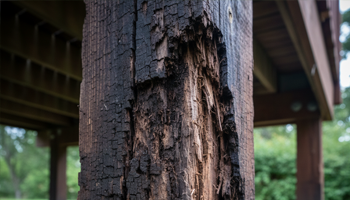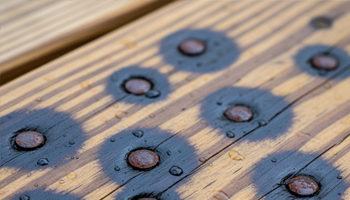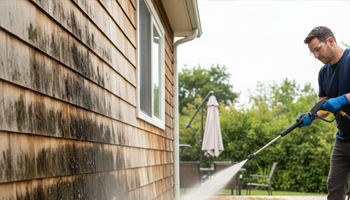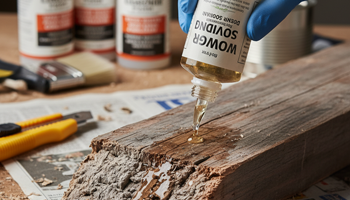Rot & Decay
Make repair decisions that address structure and moisture—not just surface cosmetics. In this child category we map rot types (soft rot, brown/white rot) to the right repair depth (stabilize, patch, or replace), then set design/maintenance fixes that stop the recurrence.
Diagnose First: Type, Extent & Moisture Path
Probe with an awl and moisture meter to confirm decay vs. mere discoloration. Track how water gets in: end grain, ground contact, trapped ledgers, or unflashed seams. If cross-section loss or embedment is significant, plan structural repairs before finishing.
Read next: Wood Restoration
Where Rot Starts (Hot Spots)
-
Post bases & ground contact (wicking, splashback, embedded set).
-
Horizontal joints & end grain (capillary soak).
-
Fastener penetrations (unsealed paths, galvanic stains).
Read next: Soft Rot in Deck Posts
Repair Paths: Stabilize, Patch, or Replace
Choose the lightest method that restores capacity and blocks water:
-
Stabilize (consolidate): For early decay with solid surrounding wood. Saturate with a penetrating consolidant to harden fibers before any fill.
Read next: Wood Rot Consolidants
-
Patch (fill/rebuild): After consolidation, rebuild shape with appropriate filler/epoxy; re-drill pilots and refasten correctly.
Read next: Wood Filler vs Epoxy for Exterior Repairs
-
Replace: When loss exceeds safe limits, loads are high, or decay is at critical connections (e.g., embedded posts/ledgers).
Read next: Soft Rot in Deck Posts
Deck Posts & Bases (Most Failures Start Here)
Break ground contact, add capillary breaks, and ventilate bases. If posts are embedded or set below grade, expect recurring soft rot without a redesign (elevated brackets, drainage, and sealed cuts).
Read next: Soft Rot in Deck Posts • Materials choice: Wood Filler vs Epoxy for Exterior Repairs
Process Controls (So Repairs Last)
Dry to safe MC before consolidating or filling; seal end grain; prime/coat cut edges; and use compatible fasteners to avoid iron-tannin staining that masks moisture problems.
Read next: Consolidation workflow: Wood Rot Consolidants • Stain protocol after repairs: Remove Stains from Wood Siding & Decks
Prevention & 10-Year Cost
Redirect water (flashings, drips, kerfs), improve airflow, clean organics seasonally, and choose finishes aligned to sun/shade and maintenance appetite. Treat biological films early so they don’t trap moisture against wood.
Read next: Maintenance chemistry: Best Deck Mildew Remover • Mold safety & dwell times: Black Mold on Deck
Read next (summary):
Soft Rot in Deck Posts: Identification, Repair or Replace Decision Guide Safety First: This is a structural decision with real liability. If you’re unsure after reading this guide, replace the post or get a qualified pro to assess it. A sagging or compromised support can cause partial collapse. Understanding Soft Rot: What It Is and […]
Soft Rot in Deck Posts Leer más »
Nail & Screw Staining on Wood If you’re seeing blue-black halos around deck screws or rusty teardrops bleeding down siding, this guide will save you thousands. Staining from nails and screws isn’t “patina”—it’s a preventable failure that starts the day the wrong fastener touches the wrong wood in the presence of moisture. After two decades
Nail & Screw Staining on Wood Leer más »
How to Remove Tannin Stains from Wood Siding & Decks Short version: If you correctly diagnose whether you’re seeing true tannin bleed or an iron–tannin reaction, and you pair that with oxalic acid, proper neutralization/rinsing, and patient drying (48–72 hours, ≤15% MC) before priming, you’ll stop the stains and keep them from coming back. Below
Stains on Wood Siding & Decks Leer más »
Penetrating Epoxy vs PC Products In-Depth Review If you’re deciding between penetrating epoxies and off-the-shelf consolidants like PC-Petrifier, this guide breaks down how they work, when to use them, and how they actually perform in the field—plus the real cost per square foot when you apply enough product to do the job right. Quick take:
Wood Rot Consolidants Leer más »




